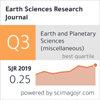Runoff Curve Number (CN model) Evaluation Under Tropical Conditions
IF 0.5
4区 地球科学
Q4 GEOSCIENCES, MULTIDISCIPLINARY
引用次数: 1
Abstract
In tropical countries the Curve Number method (CN) of the Soil Conservation Service (SCS) is widely used in civil engineering (to calculate drainage infrastructure) as well as in agricultural and environmental studies. However, little is known about the accuracy of CN method in tropical watersheds. To reveal the CN method accuracy, this study compares the CN method results with field data measured in an Andean micro watershed. For this, CN values for the tropical micro watershed "La Vega" were identified using the tables proposed by the SCS and its respective moisture and slope corrections (CNAMC2S); subsequently CN values were derived from 55 events (CNQ) in which runoff and rainfall were measured. It was observed a different of 27% between CNQ and CNAMC2S (CNQ = 80, CNAMC2S 58.1). According to that, the data shows that in the tropical micro watershed evaluated in this study, the SCS method overestimated runoff. The CN model of the SCS is strongly influenced by the antecedent humidity and its impact becomes stronger after high rainfalls records; however, the antecedent humidity influence was not observed in measured runoff data. Despite the CN – SCS model did not present a relationship between CN and precipitation, this relationship was observed in measure data. This study shows that CN method has some inaccuracies and it requires further studies to know its applicability in tropical conditions.热带条件下径流曲线数(CN模型)的评价
在热带国家,土壤保护局(SCS)的曲线数法(CN)广泛用于土木工程(计算排水基础设施)以及农业和环境研究。然而,人们对CN方法在热带流域中的准确性知之甚少。为了揭示CN方法的准确性,本研究将CN方法的结果与在安第斯微流域测量的现场数据进行了比较。为此,使用SCS提出的表格及其相应的湿度和坡度校正(CNAMC2S)确定了热带微流域“La Vega”的CN值;随后,从55个测量径流和降雨量的事件(CNQ)中得出CN值。CNQ和CNAMC2S之间的差异为27%(CNQ=80,CNAMC2S 58.1)。据此,数据表明,在本研究评估的热带微流域中,SCS方法高估了径流量。SCS的CN模型受到前期湿度的强烈影响,在高降雨量记录后其影响变得更强;然而,在测量的径流数据中没有观察到先前的湿度影响。尽管CN–SCS模型没有显示CN与降水之间的关系,但在测量数据中观察到了这种关系。这项研究表明CN方法有一些不准确之处,需要进一步研究才能知道它在热带条件下的适用性。
本文章由计算机程序翻译,如有差异,请以英文原文为准。
求助全文
约1分钟内获得全文
求助全文
来源期刊

Earth Sciences Research Journal
地学-地球科学综合
CiteScore
1.50
自引率
0.00%
发文量
0
审稿时长
>12 weeks
期刊介绍:
ESRJ publishes the results from technical and scientific research on various disciplines of Earth Sciences and its interactions with several engineering applications.
Works will only be considered if not previously published anywhere else. Manuscripts must contain information derived from scientific research projects or technical developments. The ideas expressed by publishing in ESRJ are the sole responsibility of the authors.
We gladly consider manuscripts in the following subject areas:
-Geophysics: Seismology, Seismic Prospecting, Gravimetric, Magnetic and Electrical methods.
-Geology: Volcanology, Tectonics, Neotectonics, Geomorphology, Geochemistry, Geothermal Energy, ---Glaciology, Ore Geology, Environmental Geology, Geological Hazards.
-Geodesy: Geodynamics, GPS measurements applied to geological and geophysical problems.
-Basic Sciences and Computer Science applied to Geology and Geophysics.
-Meteorology and Atmospheric Sciences.
-Oceanography.
-Planetary Sciences.
-Engineering: Earthquake Engineering and Seismology Engineering, Geological Engineering, Geotechnics.
 求助内容:
求助内容: 应助结果提醒方式:
应助结果提醒方式:


